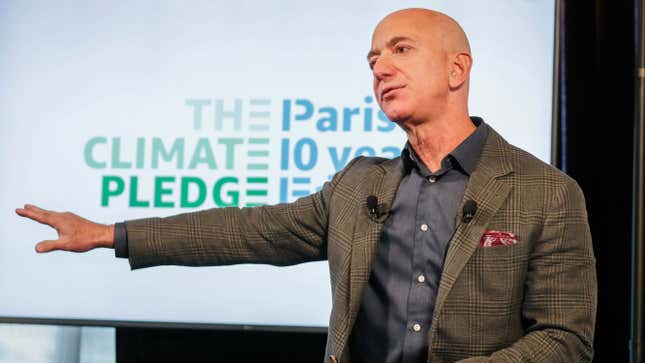
On Tuesday, the blue-and-green sign that will sit atop Climate Pledge Arena rolled out to be placed atop the home of Seattle’s new hockey team. Amazon bought the naming rights to highlight the company’s plan to get to net zero emissions by 2040 and plow $2 billion in venture capital money on its way to getting there.
The same day, the company also hosted Shell to talk about an industrywide oil and gas initiative to speed up extraction using Amazon cloud computing at AWS re:Invent, what it dubbed the “biggest cloud computing event of the year.” The multiweek conference gives companies a chance to highlight how they’re using Amazon Web Services’ cloud software to improve their bottom lines. It includes a neutrally named “energy” track that only features speakers from the oil and gas industry, including giants like Shell, ConocoPhillips, and Phillips 66. The juxtaposition shows that Amazon’s Climate Pledge is still largely a branding exercise that covers for the real damage its services are doing to the planet.
The talks by fossil fuel majors at Amazon’s marquee cloud computing conference show how deeply entangled the company is with the industry most responsible for frying the climate. Gizmodo’s previous reporting has exposed how Amazon has actively courted Big Oil partners and shown up at major oil and gas confabs to promote its services. This week’s AWS re:Invent presentations show how Amazon also invites those companies into the fold to highlight how the company’s various cloud computing software offerings are helping fossil fuel companies pinpoint where to position rigs and extract the maximum amount of fossil fuels.
The presentation by Shell’s Johan Krebbers, the company’s general manager for digital emerging technology and vice president for IT innovation, looked at the Open Subsurface Data Universe or OSDU. The universe extends well beyond Shell to include oil majors like Exxon, Chevron, BP, Equinor, Marathon, and Anadarko, as well as national oil companies like Petrobras and PTTEP. It also includes cloud computing heavy hitters beyond AWS; Google and Microsoft are also among the service suppliers for OSDU. The goal is to hoover up all sort of subsurface data oil companies gather and use an open source platform that, according to the talk description, “provides the energy industry with streamlined exploration, development, and production workflows to increase the efficiency of the full value chain.” In the case of fossil fuels, that means getting more oil and gas out of the ground more efficiently and quickly to maximize profit.
“Having always available infrastructure is critical. If, for example, you’re a geologist and you’re trying to extract a variance from a seismic cube that has to run overnight,” Liz Dennett, lead solutions architect at Amazon Web Services, said during the talk, referring to a subsurface analysis geologists do. “If that attribute extraction crashes, you could potentially delay maturing your prospect and making a drill, no drill decision. I’ve actually been there. AWS’ extensive and reliable global cloud infrastructure delivers seven times fewer downtime hours than the next largest cloud provider.”
Krebbers highlighted how the platform could do that for most of the talk before flicking at deploying it from renewables at the end. Yet as Steve Nunn, president and CEO of the Open Group, which houses OSDU, pointed out in a promotional video cut in March, the companies involved in OSDU and using AWS are all fossil fuel producers. Some, such as BP and Repsol, have said they plan to pivot more to renewables, but even then, their plans to do so are largely viewed as insufficient to meet the climate crisis.
ConocoPhillips also presented how it uses AWS cloud computing to optimize fracking operations in the Montney shale, located in British Columbia and Alberta. The company has 295,000 acres to exploit there, including a large purchase in finalized in August 2020. The talk again promised to show how ConocoPhillips used AWS to “drive down capital costs and increase operational efficiency” there. Justo Sanchez, a data analyst with ConocoPhillips, said in the talk that the data crunching system designed using AWS allowed the company to shave down data preparation from 8 hours to less than a minute.
More efficient oil and gas operations essentially speed up the clock on climate doom. A United Nations report published on Wednesday showed that countries are planning to ramp up fossil fuel production 2% per year this decade, even as science shows it needs to drop 6% per year. Amazon’s Climate Pledge is full of holes, and employees who have asked the company to address them have been fired. One of the biggest, though, is allowing oil and gas companies to not only operate, but to operate faster. So sure, the net-zero hockey arena is a nice gesture, but Climate Pledge Arena may want to invest in a strong cooling system the way Amazon keeps throwing gas on the fire.